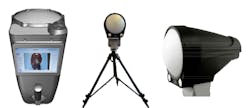Millimeter Radar Threat Level Evaluation (Mirtle)
Commack, New York, USA February 22, 2016—Aventura Technologies, Inc., an industryleader in advanced security and safety management technology will demonstrate the latest in concealed threat detection technology known as “Mirtle” Millimeter Radar Threat Level Evaluation (www.milliwaves.com) at the upcoming ISC West security conference to be held in Las Vegas from April 6-8, 2016.
What is unique about Mirtle™ is its ability to scan persons in an uncontrolled non-subject compliant environment from a setoff distance of up to 100 feet with both fixed and portable units.
Concealed Threat Detection
There is now, more than ever before, a need for technologies that enable the screening of people from a distance. A wide variety of weapons can be easily concealed under clothing and carried into crowded public sites to target national infrastructure, spread fear, and inflict mass murder and casualties. The most feared and devastating terrorist weapon is the suicide bomb or Person Borne Improvised Explosive Device (PBIED); such devices are relatively simple to conceal on the body and successful detection is required at considerable distance or stand-off range before the bomber reaches the target area. Current electromagnetic screening technologies, such as metal detectors, explosive trace detection, and x-ray backscatter are very restricted in the coverage, stand-off capability, flexibility and efficacy they afford. Perhaps the most widely known of these technologies is millimeter-wave or sub-millimeter-wave imaging, where millimeter-wave images are interpreted by a trained human operator or by computer algorithm to ascertain the presence or absence of concealed threats. However MMW imaging suffers from limited standoff.
Millimeter Wave Radar Concealed Threat Detection
A promising alternative method of concealed threat detection is to avoid image formation altogether and the restrictions that an imaging approach imposes, the greatest of which are those of limited spatial resolution and scene contrast, making interpretation and identification of concealed objects by millimeter-wave imaging difficult and often unreliable. But the essential ability of millimeter-wave radiation to penetrate clothing and gather information on concealed objects must be retained. A millimeter-wave radar system has the ability to probe objects concealed under clothing with identification of those objects being carried out by analysis of thescattered radar return. This has distinct advantages over imagery:
- Interpretation of millimeter-wave imagery is difficult and does not lend itself well to autonomous decision making whereas interpretation of scattered radar returns can, for certain types of object, be far quicker, more reliable and discriminatory. Spatial resolution requirements for a radar system are far more relaxed, since imagery is not being sought. Consequently, stand-off ranges can be extended considerably beyondthose achievable with an imaging technique.
- Speed of operation; capture rates of well in excess of 50 frames per second are easily possible.
- Radar systems are mechanically simpler than scanned millimeter-wave imaging cameras since the scene does not need to be scanned using rapidly moving mirrors as the radar is a point and detect system.
- The radar system can be integrated with conventional video or infrared imagery to show the position of the millimeter-wave beam in real time.
- Size and weight saving of a millimeter-wave radar system over an imaging system are considerable, as a result of the reduced number of components, optics, mechanical drives and power requirements
- The cost of a radar system is significantly lower since fewer, expensive millimeter-wave components are required and expensive optical components are not required.
MiRTLE is a patented W-band (75 - 110 GHz) millimeter wave, polarimetric radar system. The equipment has been developed for the detection of threat objects, particularly PBIED, concealed under clothing upon the human body at stand-off ranges of greater than 30 meters (MiRTLE 30); and a handheld version that operates at stand-off ranges of 10 meters (MiRTLE 10).
In operation, the systems implement Swept Frequency Continuous Wave radar with low cost components to deliver a compact, ultra-wide bandwidth (UWB), high resolution (around ~ 10 mm) radar system capable of detecting, discriminating, and identifying a wide spectrum of concealed threat items. MiRTLE has been developed to detect bombs, guns and knives through co- and cross-polarized radar return amplitude ratio, threat detection can be rendered autonomously by application of a neural network (NN) to the scattered polarimetric, time domain radar return.
About Aventura Technologies, Inc.
Since 1999, headquartered in New York, with facilities around the world, Aventura has been an industry leading designer, developer and manufacturer of “off-the-shelf” and custom-designed enterprise-level security hardware and software solutions for civilian and government, emphasizing end-to-end solutions. You can visit Aventura at www.AventuraCCTV.com and Mirtle at www.milliwaves.com
